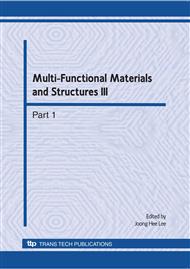p.847
p.851
p.855
p.859
p.863
p.867
p.871
p.875
p.879
Finite Element Analysis of Mass-Spring System for Measurement of Relative Moving Displacement
Abstract:
Most accelerometers are composed of a mass, a spring, and a damper. The quantification of the acceleration could be obtained from the equation of dynamic motion expressed in terms of the relative moving displacement. Therefore, if the moving displacement of a seismic mass is inferred from the output signal of a single-degree-of-freedom (SDOF) system, the acceleration could theoretically be obtained by a deformation response factor expressed in the relation between relative displacement and excited acceleration. A reflective grating panel-optical fiber sensor can measure the relative displacement by the movement of the grating panel that is attached to the seismic mass. Ultimately, this research is intended for application to grating panel-optical fiber sensors. However, in order to fabricate the adequate probe for this sensing principle, microscopic rotation (< 0.007 degree) should be prevented for stable reflectivity. Therefore, this paper describes the optimum design of the mass-spring structure which features a larger linear motion range of the leaf spring and no rotation of the seismic mass. Accordingly, finite element analyses (FEA) were accomplished for reflecting the grating panel-optical fiber sensor probe. The leaf spring was employed for the strict linear motion, and some parametric studies on the design of the leaf spring was conducted. First of all, in order to have flexibility in the leaf spring, the leaf spring is divided into N equal parts (N= 3, 4, 5). Furthermore, some parametric studies were carried out, including the length of the seismic mass, arm width, and length of the leaf spring, as well as the moment balancing design. Through the comparisons of each FEA result, the best design of the leaf spring was determined to obtain the optimum features over the measurement range of acceleration and frequency within the linear elastic of the leaf spring.
Info:
Periodical:
Pages:
863-866
Citation:
Online since:
August 2010
Price:
Сopyright:
© 2010 Trans Tech Publications Ltd. All Rights Reserved
Share:
Citation:


